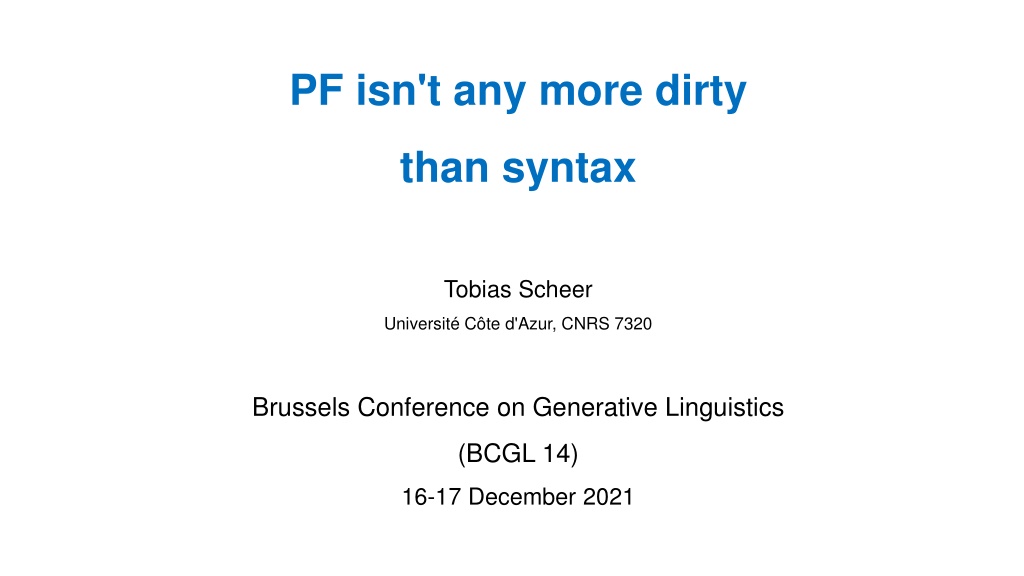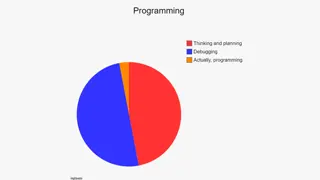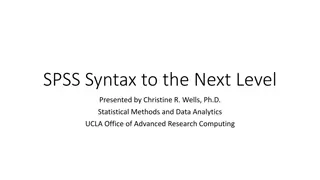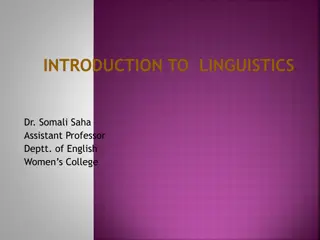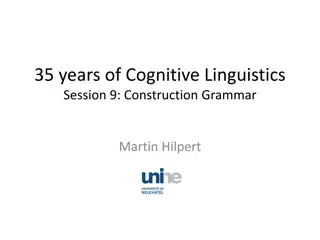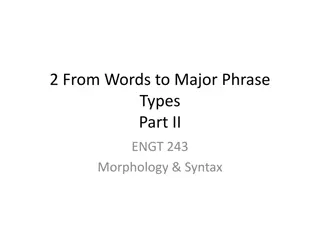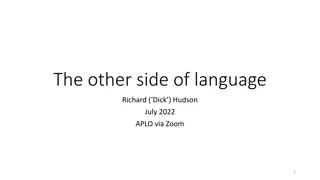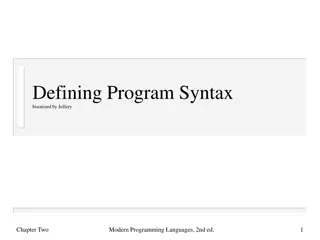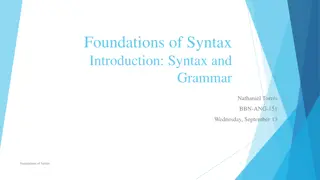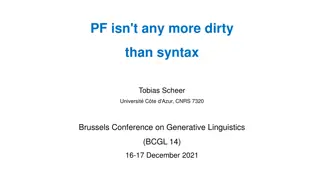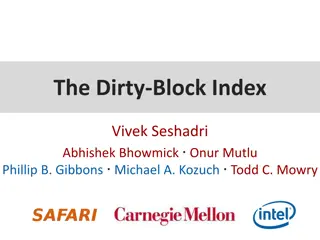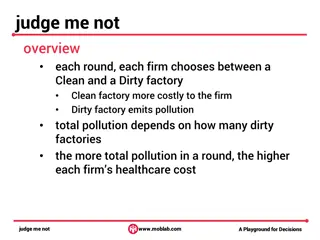Exploring Minimalism in Linguistics: Dirty PF and Clean Syntax
This text delves into the relationship between syntax and PF (Phonological Form) in the context of minimalism theory in linguistics. It discusses how minimalism aims to achieve clean syntax by discarding imperfect elements, with PF often considered as "dirty" due to its association with phonology. The content explores the role of PF as ancillary to grammar and the challenges in reconciling minimalism's goals with maintaining modularity. Additionally, it touches on Vocabulary Insertion as a crucial concept in minimalist linguistics.
Download Presentation

Please find below an Image/Link to download the presentation.
The content on the website is provided AS IS for your information and personal use only. It may not be sold, licensed, or shared on other websites without obtaining consent from the author. Download presentation by click this link. If you encounter any issues during the download, it is possible that the publisher has removed the file from their server.
E N D
Presentation Transcript
PF isn't any more dirty than syntax Tobias Scheer Universit C te d'Azur, CNRS 7320 Brussels Conference on Generative Linguistics (BCGL 14) 16-17 December 2021
1 The minimalism-created dustbin
Chomsky (1965) et passim, overview Boeckx & Uriagereka (2007) the inverted T Lexicon 1 (synt. items) morpho-syntax inverted T before minimalism phonology Lexicon 2 (phonol. items) semantics = PF
Chomsky (1965) et passim, overview Boeckx & Uriagereka (2007) the inverted T Lexicon 1 (synt. items) morpho-syntax inverted T after minimalism PF Lexicon (phonol. items) semantics ?? phonology
purpose minimalism makes syntax clean by throwing out what is not "perfect" the dustbin is the neighbor next door, PF result #1: clean syntax, dirty PF result #2: PF = phonology + X (where X = the content of the dustbin)
purpose this fits with the idea that only syntax is grammar PF is "ancillary" PF is dirty = not perfect = not part of FLN
purpose in general PF is not any more dirty than syntax phonology does not reduce to third factors it has language-specific content this content is "perfect" and thus phonology is in FLN this talk given minimalism-created PF is not a dustbin: X cannot exist PF = phonology + X X is a modular monster, i.e. incompatible with modularity it has to go
purpose agenda: to reconcile two minimalist ambitions clean syntax modularity that means PF = phonology X needs to go what could be its home? being a minimalist, you will not want to create an extra box, will you? ==> Vocabulary Insertion, i.e. the only item on the map that isn't syntax or phonology.
2 Content of the dustbin
Merchant (2001, 2004, 2018), Fox & Lasnik (2003), Gengel (2009) dustbin Chomsky (1993), Bo kovi (2001) and Franks & Bo kovi (2001) Sauerland (1998), Chomsky (2001: 21ff), Embick & Noyer (2001), Sauerland & Elbourne (2002) Non-perfect syntactic-looking phenomena that on minimalist standards do not qualify as being syntactic anymore include ellipsis of words, phrases and sometimes entire CPs deletion at PF copy deletion the highest copy is pronounced and all others are deleted "at PF" PF movement remove displacement operations from NS that do not appear to have any syntactic or semantic motivation, or which violate otherwise well-established syntactic generalizations
dustbin none of this is what phonologists call phonology ellipsis phonological computation may delete features or segments, but certainly not words, VPs or CPs no phonological theory is suited for the manipulation of this kind of object, which phonologists look at like an ant looks at a jumbo jet.
dustbin copy deletion lower copies are "deleted in PF, unless pronunciation in the head position would give rise to a PF violation" (Franks & Bo kovi 2001: 176) PF violation: absence of a "repair" strategy which places a word before the enclitic. the result is an enclitic without host, which leads to ungrammaticality. Franks & Bo kovi (2001: 175) say that the effect results from a "phonological difference" nothing of all that is phonological repairs that engage entire morphemes are certainly not the result of phonological computation phonology has no idea whether an item is a copy or not, and in case it is, whether it is higher or lower.
dustbin Embick & Noyer (2001) PF movement linearization upon Vocabulary Insertion PF movement occurs after linearization and is based on linear precedence thus hierarchical structure with syntactic labels (trees), linearity and phonological material coexist in a space where computation (PF movement) is carried out.
3 A modular monster
Modularity: Robbins (2017), Gerrans (2002), Carruthers (2006), Segal (1996) modularity Phrenology: Sabbatini (1997), van Wyhe (2004) the mind/brain is made of a number of distinct functional units that carry out computation, each being competent for a specific task (Fodor 1983). roots in 19th century phrenology (F-J Gall), which already was about the mind and the brain "the theory of linguistic structure [is], essentially, the abstract study of 'levels of representation'. [...] [A] level has a certain fixed and finite 'alphabet' of elements, which we will call its 'primes.' " LSLT (Chomsky 1955-56: 105) the so-called inverted T (or Y) describes language as a set of three distinct systems. Aspects (Chomsky 1965: 15f)
Fodor (1983: 58-64), Coltheart (1999), Carruthers (2006: 3-12), Collins (2017: 224), Jackendoff (1997: 41, 2002: 218-227). modularity domain specificity Jackendoff (1997: 41), Chomsky (2000: 118) modules are only competent for their own domain most prominent split in language: they work on their own proprietary vocabulary syntax, morphology, semantics since different modules do not speak the same language, they cannot interpret the vocabulary of their neighbours phonology labiality number stopness person translation modularity enforces translation voicing animacy if modules want to exchange information, the vocabulary of the sending module needs to be translated into the vocabulary of the receiving module palatality mood sonorancy voice tone quantification
a modular monster the coexistence of two distinct vocabularies in a computational system (module) is excluded. no person, number, gender etc. in phonology no labiality, occlusion etc. in morpho-syntax Vocabulary Insertion is the translation between morpho-syntax and phonology therefore the minimalism-created PF-but-not-phonology system cannot exist it has syntactic trees and labels after VI, i.e. in presence of phonological material
a modular monster post-VI plus syntactic trees & labels: is the environment of all PF-but-not-phonology processes mentioned copy deletion, ellipsis, PF movement
4 Growing up: back to where we started
Chomsky (1965) et passim, overview Boeckx & Uriagereka (2007) the inverted T Lexicon 1 (synt. items) morpho-syntax inverted T before minimalism phonology Lexicon 2 (phonol. items) semantics = PF
the inverted T inverted T with minimalist Lexicon 1 (synt. items) morpho-syntax teething troubles and an innovation: PF Late Insertion semantics ?? Lexicon (phonol. items) phonology VI grown up phonology minimalism
historical situation sealed suitcases up to and including GB VI took place at the outset of syntactic computation (during numeration) phonological material was hooked on morphemes and carried through syntactic computation without doing anything (sealed suitcases) sealed suitcases crashed for two reasons the input to syntax: pieces were smaller and smaller and at some point below the size of a morpheme = a Vocabulary Item. ==> explosion of the functional sequence Late Insertion (DM)
historical situation then minimalism entered the scene Minimalism was not the reason for Late Insertion and the ruin of sealed suitcases. but it was independently reinforcing the focus on (late) VI: syntax is interface-driven. a first reaction on minimalist requirements: understandable, but we need to unload stuff from syntax, where does it go? to the neighbor downstairs, we'll call it PF instead of phonology. phonology is dirty anyway because outside of FLN, so our dirty stuff can go there. a first reaction on Late Insertion by DM: understandable, but the output of syntax and our Vocabulary Items don't match. How do we get them to match? by brute force: fission, fusion, impoverishment. this is the negation of our own ambition (one engine, morphology is syntax with smaller pieces, but fission etc. is unheard of in syntax), but we don't talk too much about it.
historical situation growing up, leaving teething troubles behind us PF-but-not-phonology (the minimalist dustbin) needs to go fission, fusion, impoverishment need to go a third item may be added: allomorphy computed in an undefined intermundia (modular no man's land) where could all this go? to Vocabulary Insertion which is the only place on the map that exists anyway as minimalists, we don't want to add more dustbins, do we? see Newell & Sailor's and Sailor's talks
historical situation the elephant in the room nanosyntax does all that no modularity-violating component (PF-but-not-phonology) no fission, fusion, impoverishment no allomorphy calculus anywhere (allomorphy is VI) just spell-out and VI labor shifted back to syntax rather than after VI, all this is managed before and upon VI recall that this was the conclusion reached earlier: shift of labor from PF to VI massive spell out-driven syntactic movement to create the syntactic structure required by the lexical items available. who is bothered by interface labor? current: phonologists, modularity nanosyntax: syntacticians
5 Growing up #2: who does the interface?
who does the interface? phonology-centrism interface theories have always been designed by phonologists: SPE, Lexical Phonology, Prosodic Phonology why? Because the output of the interface heavily impacts the phonologist's job. you cannot do phonology without knowing what comes down from morpho-syntax. but you can do syntax without knowing where the result goes: ==> fire and forget what about DM? DM is a theory of morphology, not of the interface classically, DM is done by syntacticians. No phonologists around. Phonology isn't really a concern. When phonology appears, it's in the guise of SPE (Halle's heritage).
who does the interface? know thyself, know the other, talk to the other the minimalism-created dustbin exists because the syntacticians who have made it didn't talk to phonologists didn't have modularity on their agenda for a long time (and still today), phonologists were happy with their domestic interface theories: Glyne Piggott and Heather Newell have tried to missionarize phonologists regarding DM and phases, with little success.
who does the interface? to get the interface right, we need more phonologists who know about syntax we need more phonologists who know about morphology: ==> Piggott, Newell, Bonet, Mascar , Nevins, Berm dez-Otero, Faust, Lampitelli we need more syntacticians who know about phonology we need more synt-phon couples working together Sailor - Newell d'Alessandro - Scheer Cheng - Dowining
who does the interface? there is space for progress syntacticians confuse PF and phonology Bo kovi ' (2001) book is called "On the nature of the syntax-phonology interface. Cliticization and related phenomena" "[t]here are some reasons to suspect that a substantial core of head raising processes [ ] may fall within the phonological component." Chomsky (2001: 37) syntacticians confuse phonology and phonetics PF is the Phonetic Form (Chomsky 1995: 2, 14f) "[t]he PF repre sentation is a string of phonetic primes with syllabic and intonational structure indicated, derived by a computation from " (Chomsky 1995: 35)
who does the interface? what happens when DM gets interested in phonology (and vice-versa) phonologically conditioned allomorphy (PCA) is losing its teeth PCA is a challenge for modularity more and more cases turn out to be no allomorphy after all: there is one single lexical entry and the alternation observed is pure phonology. Faust, Lampitelli & Ulfsbjorninn 2018: Italian def. article special issue of Morphology 2016: Allomorphy - its logic and limitations (Faust & Lampitelli eds.) Lampitelli (2010), Passino (2014): phonological exponence of phi features in Italian. Lampitelli (2013): phonological exponence of case markers in Bosnian. etc. morphological classes are reduced to phonology Newell (2021): English class 1 vs. class 2 is a phonological distinction.
6 No escape from syntax: don't try to have your own computational domains in the privacy of your phonology
domains how many means are there to define computational domains? minimalism-born phase theory: domains are defined in morpho-syntax (phase heads) they are shipped to phonology there is no way phonology does not receive the pieces, or receives different pieces: the pieces shipped and received are the same
domains interface conceived by phonologists domains below the word level are defined by morphology: cycles / strata domains above the word level are defined outside of morpho-syntax (readjustment in SPE, mapping rules in the 80s, Align constraints in OT) and incarnate as representational items ==> the Prosodic Hierarchy the claim was non-isomorphism: phonological domains may be distinct from morpho-syntactic domains. Kiparsky (1982): post-lexical phonology is non-cyclic meaning that there are no derivationally defined computational domains for items above the word size this cannot be correct if there are phases
D'Alessandro & Scheer (2015) domains Pak (2008), Scheer (2008), Samuels (2011a,b), Newell (2018: 200-213) adapting phase theory to the demands of phonology is a minimalist concern: interface-driven design another minimalist concern is the reduction of the number of devices can the two devices that define domains be reduced to just one? phase theory (morpho-syntacticians), cycles / strata (phonologists) Prosodic Hierarchy (phonologists) what is it that the Prosodic Hierarchy can do, and which cannot be done by a phase-based management? if phase theory is adapted to the demands of phonology, the answer is: nothing.
domains D'Alessandro & Scheer (2015) adapting phase theory to the demands of phonology observation: computational domains based on syntactic and phonological evidence may or may not coincide some domains relevant on one side leave no footprint on the other side. implementation domains are only defined in morpho-syntax: phases phases leave a footprint if they are associated to a PIC in case they are not, they leave no trace for any given phase, there may or may not be a PIC in syntax there may or may not be a PIC in phonology debate: Bonet, Cheng, Downing, Mascar (2019)
domains D'Alessandro & Scheer (2015) Abruzzese logical possibilities of (mis)match between Spell-Out and PIC PIC in syntax PIC in phon. illustration phonological phenomenon + + Abruzzese: transitive active v Raddoppiamento Fon. + Abruzzese: unaccusative v Raddoppiamento Fon. Abruzzese: passive v Raddoppiamento Fon. + Abruzzese: C Raddoppiamento Fon. English: vP t-flapping
domains Ledgeway (2017) Southern Italian dialects PIC in syntax PIC in phon. application of RF dialect + + No Cosentino + Yes S. Giorgio del Sannio, Bitteto + No S. Benedetto del Tronto Yes Cosentino
domains learning from each other it's the same pieces that are shipped and received there is syntactic evidence for them of course always taken into account by syntacticians part of it (below the word level) taken into account by phonologists there is phonological evidence for them syntacticians should also look into phonology to find evidence for syntactic domains.
